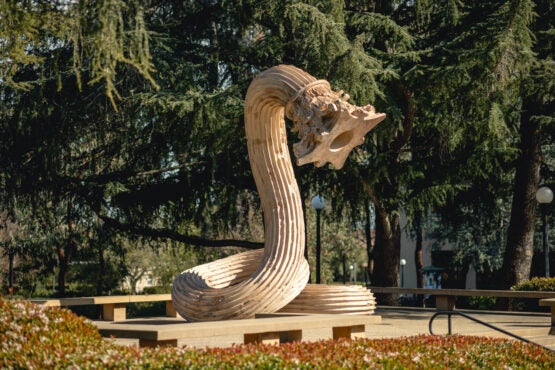February 4, 2022
A new sculpture on the edge of Meyer Green greets passersby
Modeled after an ancient Greek column, but with a twist, “Hello” by international artist Xu Zhen is both familiar and surprising. Watch the video here.
By Robin Wander
A seemingly ancient Greek column topped with a Corinthian capital sits coiled and watchful atop the bowl of Meyer Green. Hello, by international conceptual artist Xu Zhen, is the newest outdoor artwork on the Stanford campus and the inaugural commission for the Stanford Plinth Project.

Hello by Xu Zhen. (Image credit: Instillation by Xu Zhen; image by Andrew Brodhead)
The artist created the 15-foot sculpture especially for Meyer Green, a 2.45-acre open space located close to several university landmarks, including Green Library, the Law School and the Graduate School of Education. He combined traditional bronze techniques with the latest digital sculpting technology to create something that looks both ancient and contemporary. Its form is based on Greek architecture pillars, symbolizing the origin and cornerstone of Western civilization. As viewers move close, they will notice that the towering column is twisted in the form of a magnified and mutated snake, observing its surroundings from its perch on a plinth surrounded by soaring cedars.
The work fuses the classical Greek column shape and the snake’s aggressive biological attitude to stimulate viewers’ perception and experience of classic civilization. The moment the viewer’s eyes come across the Corinthian capital also represents a confrontation with the depth of history and culture. With the increasingly frequent blending and impacts among global civilizations, the work constitutes both a reality and a metaphor for encountering civilizations of different times and space. “It is hard to define an artist as someone who just produces art pieces,” said Xu Zhen in a 2017 interview. “He is perhaps someone who changes the way people think.”
In 2019, Stanford’s Public Art Committee chose Xu Zhen to create a site-specific outdoor work of art for the Plinth Project. This new initiative places a series of temporary, commissioned public artworks in the central Meyer Green campus location where the Meyer Library stood from 1966 to 2015. The work was to be installed the following year, but due to the pandemic, the installation was delayed. Xu Zhen was chosen in part for his representation of global perspectives and his engagement with issues relevant to the university. In his statement about creating Hello, he writes: “Located in Silicon Valley, Stanford University plays an important role in terms of innovations, developments and discovery of new talent. The people of this distinguished university share similar qualities with contemporary artists: the capability to see new possibilities and the courage to explore opportunities, even though results remain uncertain.”
Expanding public art on campus
The installation of Xu Zhen’s work builds on the committee’s strategy around public art that brings more temporary and permanent public art to campus. Examples of recent outdoor art include Alicja Kwade’s 12-part, permanent piece Pars pro Toto in the Science and Engineering Quad; Kiyan Williams’ temporary iteration of Reaching Towards Warmer Suns on the Anderson Collection grounds in 2021; and Sam Van Aken’s Tree of 40 Fruit rooted between the McMurtry Building and the Rodin Sculpture Garden at the Cantor Arts Center. There are also extensive site-specific art programs at Stanford’s new hospital and at the Stanford Redwood City campus that complement the over 80 public artworks on the main campus.
The Stanford Plinth Project is a key component of a new vision for public art that engages with the university’s academic mission and reflects its dynamic spirit. Modeled after the Fourth Plinth in London’s Trafalgar Square, the Stanford Plinth Project commissions allow for innovation in the works selected and a greater ability to reflect the current cultural moment, as well as meaningful campus engagement opportunities. Hello will be on view for two years.
“Hello is an exciting sculpture, and the rotating ‘plinth’ concept is a key part of the Public Art Committee’s strategy for dynamism. The works will engage the community and enliven this central area of campus that encompassed both Meyer Green and Canfield Court,” said Matthew Tiews, interim senior associate vice president for the arts and associate vice president for campus engagement, who chairs the committee.
Isabel Benak, a senior majoring in art history and minoring in modern languages who serves on the Public Art Committee, concurred with Tiews. “Public art is such a big part of our campus’ spirit and being able to experience this monumental work in person after being away from campus for so long is incredibly exciting. It really feels like the campus is alive again,” Benak said. “I think this sculpture is coming at an essential time for Stanford, both as students return and the campus regains its spirit, and a time when students and professors are rethinking the prominence of western civilization in many of our studies.”
About the artist
Xu Zhen is a conceptual artist whose work often takes the form of provocative sculptures, installations and interventions that confront sociopolitical taboos in contemporary China and freely manipulate western expectations of Chinese art and commerce. Born in 1977 and living and working in Shanghai, Xu Zhen has exhibited internationally at museums and biennales such as the Venice Biennale, Museum of Modern Art, Tate Liverpool and Ullens Center for Contemporary Art, Beijing. Xu Zhen is also a curator and was one of the initiators of Art-Ba-Ba, a leading online forum for discussion and critique of contemporary art in Shanghai.
In 2009 Xu Zhen established MadeIn Company – an “art creation company” focused on the production of creativity and devoted to the research of contemporary culture’s infinite possibilities. In 2013, MadeIn Company launched the brand “XU ZHEN®,” making Xu Zhen a product of his own corporation.
-30-
|